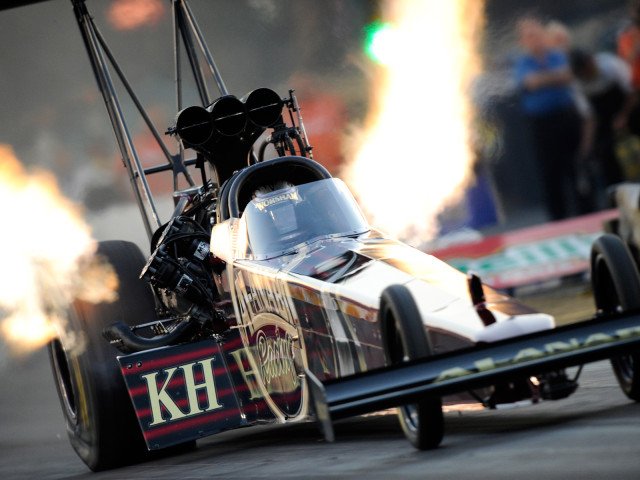Just in case you ever wondered why a Top Fuel dragster needs to be torn down and rebuilt after each run, here are some fun facts that we picked up over at SCCOLA.com’s website:
- One Top Fuel dragster outfitted with a 500 cubic-inch replica Chrysler Hemi (Keith Black, etc) engine makes more horsepower (8,000 HP) than the first 4 rows of cars at NASCAR’s Daytona 500.
- Under full throttle, a dragster engine will consume 11.2 gallons of nitro methane per second; a fully loaded Boeing 747 consumes jet fuel at the same rate but with 25% less energy being produced.
- A stock Chrysler 426 Hemi engine cannot produce enough power to even drive the dragster’s supercharger.
- With 3000 CFM of air being rammed in by the supercharger on overdrive, the fuel mixture is compressed into a near-solid form before ignition. Cylinders run on the verge of hydraulic lockup at full throttle.
- At the stoichio-metric 1.7:1 air/fuel mixture for nitro methane, the flame front temperature measures 7050 degrees F.
- Nitro methane burns yellow. The spectacular white flame seen above the stacks at night is raw burning hydrogen, disassociated from atmospheric water vapor by the searing exhaust gases.
- Dual magnetos supply 44 amps to each spark plug, which is typically the output of a small electric arc welder in each cylinder.
- Spark plug electrodes are totally consumed during a pass. After 1/2 way through the run, the engine is “dieseling” from compression and the glow of the exhaust valves at 1400 degrees F. The engine can only be shut down by cutting the fuel flow.
- If spark momentarily fails early in the run, unburned nitro builds up in the affected cylinders and then explodes with enough force to blow the cylinder heads off the block in pieces or split the block in half!
- Dragsters reach over 300-plus MPH …before you have completed reading this sentence.
- In order to exceed 300 MPH in 4.5 seconds, a dragster must accelerate an average of over 4 G’s. In order to reach 200 MPH well before reaching half-track, at launch the acceleration approaches 8 G’s.
- Top Fuel engines turn approximately 540 revolutions from light to light!
- Including the burnout, the engine must only survive 900 revolutions under load.
- The redline is actually quite high at 9500 RPM.
- Assuming all the equipment is paid for, the pit crew is working for free, and nothing blows up, each run will cost an estimated $1,000 per second.
- 0-to-100 MPH in .8 seconds (the first 60 feet of the run)
- 0-to-200 MPH in 2.2 seconds (the first 350 feet of the run)
- 6 G-forces at the starting line (nothing accelerates faster on land) 6 negative G-forces upon deployment of twin parachutes at 300 MPH.
- An NHRA Top Fuel Dragster accelerates quicker than any other land vehicle on Earth, quicker than a jet fighter plane, the space shuttle or snapping your fingers!
- The top speed record is 337.58 MPH as measured over the last 66′ of the run (2005, Tony Schumacher).









